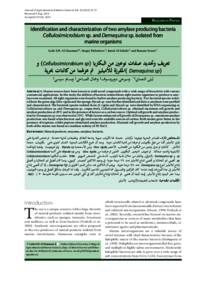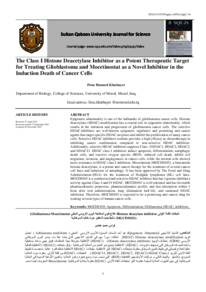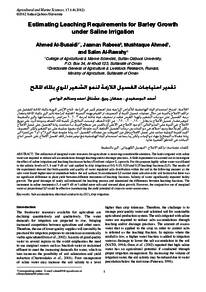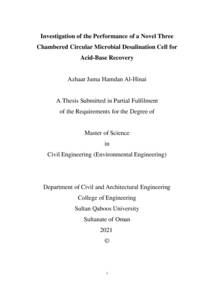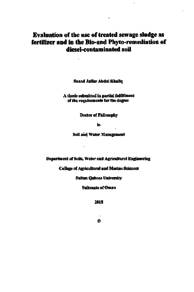Document
Identification and characterization of two amylase producing bacteria Cellulosimicrobium sp. and Demequina sp. isolated from marine organisms.
Contributors
Publisher
جامعة السلطان قابوس. كلية العلوم الزراعية والبحرية
Gregorian
2015
Language
English
English abstract
Marine sources have been known to yield novel compounds with a wide range of bioactivity with various commercial applications. In this study, the abilities of bacteria isolated from eight marine organisms to produce α-amylase were examined. All eight organisms were found to harbor amylase producing bacteria. Two bacterial species isolated from the green alga Ulva rigida and the sponge Mycale sp. were further identified and their α-amylases were purified and characterized. The bacterial species isolated from U. rigida and Mycale sp. were identified by DNA sequencing as Cellulosimicrobium sp. and Demequina sp., respectively. Cellulosimicrobium sp. obtained maximum cell growth and amylase production at 29ºC and in the presence of lactose as a carbon source. Optimal cell growth and amylase production by Demequina sp. was observed at 35ºC. While lactose enhanced cell growth of Demequina sp., maximum amylase production was found when fructose and glycerol were the available sources of carbon. Both strains grew better in the presence of tryptone, whilst peptone stimulated amylase production. Maximal cell growth and amylase production by both of the strains was found at a medium salinity of 3% NaCl.
Member of
ISSN
2410-1079
Resource URL
Citation
Al-Naamaniyah, L. S. H., Dobretsov, S., Al-Sabahi, J., & Soussi, B. (2015). Identification and characterization of two amylase producing bacteria Cellulosimicrobium sp. and Demequina sp. isolated from marine organisms. Agricultural and Marian Sciences Jou
Arabic abstract
تعرف المصادر البحرية بتوفيرها لمركبات جديدة لها تأثيرات حيوية واسعة النطاق وتطبيقات تجارية متعددة. تم فحص القدرة على إفراز الأميليز ألفا من قبل بكتريات تم عزلها من ثمانية كائنات بحرية. وجد أن جميع الكائنات البحرية الثمان تحتوي على بكتريات منتجة للأمليز. كذلك تم عزل نوعن من البكتريا من الطحلب الأخضر Ulva rigida ومن الأسفنجية Mycale sp وتم تعريفهما، وتنقية إنزيماتهما الأميليزية وتحديد صفاتها. تم تعريف النوعين البكتريين اللذين تم عزلهما من Ulva rigida ومن Mycale sp على أنهما Cellulosimicrobium sp و Demequina sp بالتوالي، وذلك من خلال تقنية الترتيب التسلسلي للحمض النووي DNA حققت البكتريا Cellulosimicrobium sp. أقصى نمو للخلايا وأقصى إنتاج للأميليز عند 29 درجة مئوية في وجود اللاكتوز كمصدر كربوني، بينما كان أفضل نمو للخلايا وأفضل إنتاج للأميليز لنوع Demequina sp عند 35 درجة مئوية. ورغم أن اللاكتوز قد حسَّن النمو الخلوي ل Demequina sp إلا أن أقصى إنتاج للأميليز في هذا النوع قد وُجِد عندما كان الفركتوز والجيسرول هما المصدرين المتاحين للكربون. ولقد نما النوعان بشكل أفضل في وجود التريبتون، بينما حفز الببتون إنتاج الأميليز. وُجِد أيضا أن أقصى نمو للخلايا وإنتاج للأميليز كان في كلي النوعين عند مستوى الملوحة المتوسط 3% NaCl.
Category
Journal articles

